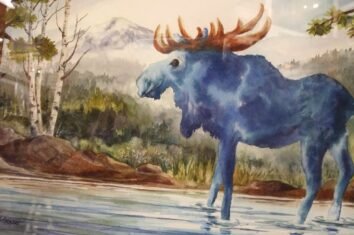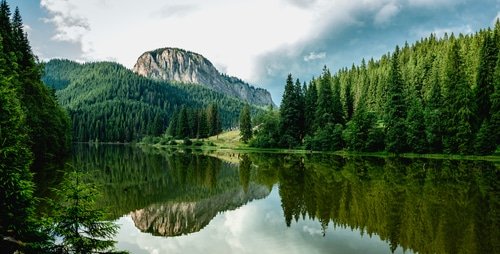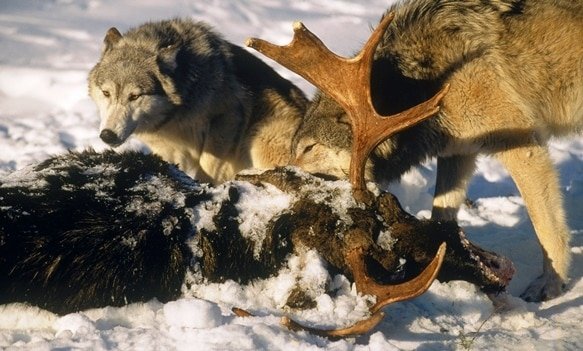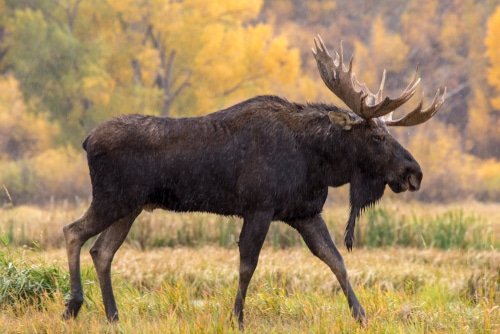From the earliest cave paintings to modern masterpieces, moose have held a special place in artistic representation. These majestic creatures, with their towering antlers and imposing presence, have captivated the imagination of artists throughout moose art history.
The moose’s size and strength have symbolized power, nobility, and spirituality in various cultures. In indigenous traditions, the moose often represents wisdom and harmony with nature.
More recently, moose have also become icons of wilderness and conservation. Whether it’s their grandeur or their symbolic associations, there is no doubt that moose holds a unique allure for artists seeking to capture the essence of these magnificent beings.
The evolution of moose art parallels the development of artistic styles throughout history. In ancient times, cave paintings depicted rudimentary but recognizable representations of these creatures in their natural habitat. As civilizations progressed, so did artistic techniques.
During the Renaissance, we see more refined depictions of moose in paintings and sculptures as artists sought to portray them with greater realism and attention to detail. With the advent of modern art movements like Impressionism, Cubism, and Surrealism came new interpretations that pushed the boundaries of traditional representation – capturing physical likeness and expressing emotions or abstract concepts through imaginative renditions of these animals.
Today’s moose art showcases a diverse range from traditional oil paintings to contemporary mixed-media installations pushing boundaries like never before. Through this journey across time, we can witness how artistic techniques evolved and how our perception and understanding of art itself and its subject matter – in this case, glorious moose – expanded over centuries.
Exploration of early cave paintings featuring moose
Something is mesmerizing about the ancient cave paintings that have survived the test of time. And among these captivating depictions, moose find their place as one of the favored subjects. Our ancestors left remarkable portrayals of these magnificent creatures in caves scattered across Europe, such as Altamira in Spain and Lascaux in France.
The artists skillfully captured the essence of the moose, its towering antlers stretching towards the heavens, its sturdy frame exuding strength and grace. These paintings offer a glimpse into a long time when humans lived in harmony with nature and held profound reverence for it.
Discussion of the symbolism and cultural importance attached to moose in ancient civilizations
In ancient civilizations, moose held great symbolic significance and cultural importance. They were often perceived as powerful beings representing strength, nobility, and fertility. The stature and majesty of the moose resonated deeply with these societies, leading to their inclusion in various rituals and ceremonies.
For instance, among some Native American tribes, like the Algonquian people, moose were considered sacred animals with spiritual qualities. The belief was that by capturing their essence through art or rituals, they could tap into these divine attributes for protection or success.
The symbolism attached to moose extended beyond their physical characteristics; their presence represented abundance and sustenance. Moose hunting was vital in providing food for communities during cold winters when other resources were scarce.
Therefore, it’s no surprise that these mighty creatures found themselves immortalized in art – an acknowledgment of their indispensability to survival. As we delve deeper into the evolution of moose art history from ancient times to modernity, we begin to unravel the intricate tapestry woven by our ancestors’ hands – a testament to humanity’s enduring fascination with this majestic creature.
Moose in Renaissance Art
Moose depictions in Renaissance paintings and sculptures
During the Renaissance, artists sought inspiration from the natural world, including animals. The moose appeared in several artworks of the time, reflecting the fascination with wildlife.
Paintings and sculptures featuring moose were created by renowned artists like Leonardo da Vinci and Albrecht Dürer. These works showcased a growing interest in capturing the beauty and majesty of these magnificent creatures.
Painters depicted moose with great attention to detail, emphasizing their distinct antlers, muscular bodies, and expressive eyes. Sculptors, conversely, experimented with different materials to bring out the physicality and grace of moose through stone or bronze sculptures.
Role of moose as a symbol of power and nobility during this period
In Renaissance art, symbolism played a significant role. Including moose in artistic representation was seldom accidental; it served a deeper purpose.
Moose were associated with power, strength, and nobility during this era. Artists used them as symbols to convey notions of dominance or authority to viewers.
By depicting these majestic creatures alongside important figures such as rulers or wealthy patrons, artists aimed to enhance their subjects’ perceived status and influence. The imposing size and regal presence of moose conveyed an aura of grandeur that resonated with ideas surrounding social hierarchy prevalent at that time.
The evolution of moose art throughout the Renaissance showcased not only artistic skill but also reflected societal beliefs about power dynamics and perceptions of nature’s magnificence. Through careful examination and analysis of these depictions, we can understand how notions of nobility intersected with artistic expression during this remarkable historical era.

Moose as a Subject in Modern Art Movements
Exploring Moose in Impressionism, Cubism, and Surrealism
In modern art movements, the majestic moose has made its presence known in various ways. From the dreamy brushstrokes of Impressionism to the fragmented and abstract forms of Cubism and even the bizarre imagery of Surrealism, artists have found inspiration in this magnificent creature. Each movement approached the representation of moose with its own unique style and artistic vision, reflecting the evolution of moose art throughout history.
The Artists Behind Moose Artworks and Their Motivations
Countless artists have been captivated by the allure of incorporating moose into their works. In Impressionism, renowned painters such as Claude Monet and Pierre-Auguste Renoir sought to capture the essence of nature’s beauty through their lively brushwork, often including moose within idyllic landscapes. The motivations behind featuring moose ranged from celebrating nature’s harmonious relationship to showcasing a powerful symbol within their compositions.
Moving into Cubism, revolutionary artists like Pablo Picasso and Georges Braque challenged traditional notions of perspective by deconstructing forms into geometric shapes. Moose became subjects for experimentation, fragmented into angular planes that conveyed a sense of dynamism and multidimensionality within their artworks.
As for Surrealists like Salvador Dalí and René Magritte, moose served as enigmatic symbols that defied logic and invited viewers into surreal dreamscapes. The inclusion of moose within seemingly unrelated or irrational scenarios was a deliberate act aimed at evoking emotions or provoking thoughts that transcended conventional interpretation.
Throughout these modern art movements, artists looked beyond mere representation; they explored the expressive potentiality inherent in portraying these magnificent creatures. Whether it was capturing nature’s fleeting beauty or challenging preconceived notions through abstraction, these artists left a profound mark on moose art’s evolution, forever immortalizing this majestic animal’s spirit within the annals of artistic history.
Moose Artifacts and Sculptures
Exploration of unique artifacts featuring engraved or sculpted images of moose throughout history
Throughout the ages, the majestic moose has captivated human imagination, finding its place in paintings, sculptures, and various artifacts. These remarkable pieces show how earlier civilizations admired and revered this magnificent creature.
From engraved bone fragments to intricately sculpted figurines, the presence of moose in artistic representation demonstrates the enduring fascination that humans have had with these gentle giants. By examining these artifacts, we gain insight into moose’s cultural significance and role in ancient societies.
One particularly intriguing artifact is an ancient stone carving discovered in a remote cave deep within the forests of Scandinavia. The carving depicts a group of hunters surrounding a grand moose, capturing an intense moment frozen in time.
The attention to detail is exquisite—the texture of the animal’s fur and the fierce determination etched onto the hunters’ faces—all skillfully rendered on this small stone slab. This artifact reveals our ancestors’ hunting practices and their profound respect for this elusive creature.
Highlighting notable examples, such as ancient jewelry or ceremonial objects adorned with moose motifs
In addition to sculptures and carvings, various forms of jewelry and ceremonial objects have showcased intricate moose motifs over centuries. Ancient civilizations understood that adorning themselves with symbols representing strength and grace could invoke these qualities within themselves or provide protection from harm.
One extraordinary example is an ornate pendant discovered among Viking burial remains dating back to the 9th century. Crafted from gleaming silver, it features an elaborate depiction of a regal moose standing proudly against a backdrop of swirling patterns reminiscent of Nordic landscapes.
This pendant likely held deep significance for its owner—a symbol of status and a connection to the natural world and the spiritual power embodied by the moose. Another remarkable find is an intricately carved ivory comb from ancient indigenous cultures of North America.
Delicately etched into its surface are scenes of moose roaming through lush forests, their antlers reaching toward the heavens. This practical and decorative comb tells a story of harmony between humans and nature—a tale preserved in the tiniest details.
These artifacts remind us that moose have held a special place in human history and culture, their image immortalized in various forms. They are not merely animals; they embody strength, grace, and a deep reverence for the natural world—a testament to the evolution of moose art throughout millennia.
Significance and Mythology Surrounding Moose Art
The Majestic Symbolism of the Mighty Moose
Oh, the moose! These magnificent creatures have captured the imagination of cultures across the globe for centuries. It’s no wonder they hold a special place in the art world.
Different cultures have attributed various symbolic meanings to moose in artistic representation, often associating them with strength, power, and nobility. In Native American folklore, moose are revered as spiritual beings embodying courage and wisdom.
Their massive antlers symbolize authority and dominance, inspiring awe and respect among indigenous communities. These symbolic associations have greatly influenced how moose are portrayed in art throughout history.
Mythological Tales Woven Around Moose
With such symbolism attached to them, it’s not surprising that mythological stories and folklore featuring moose abound in different cultures. In Norse mythology, for instance, we come across Eikþyrnir—a majestic stag identified with a moose—who resides atop Valhalla (the Norse equivalent of heaven), grazing on Yggdrasil—the sacred tree that connects all worlds.
This mythical creature is believed to symbolize the interconnectedness of life and nature itself. Similarly, in Russian folklore, there are tales of powerful forest spirits who take the form of moose to guide lost travelers safely through dense forests.
Throughout history, artists have been inspired by these captivating mythological tales surrounding moose and have incorporated them into their masterpieces. The influence is undeniable whether it be paintings depicting ancient legends or sculptures portraying mythical creatures with antlers resembling those of a mighty moose.
The evolution of moose art showcases how different cultures have embraced these fascinating animals as important symbols within their unique mythologies. From cave paintings depicting early human encounters with majestic moose to Renaissance masterpieces embodying these creatures’ grandeur and mightiness, the cultural significance and mythology surrounding moose in art continue to awe and inspire us.
Moose Conservation Efforts through Art
Exploration of how artists have used their work to raise awareness about conservation efforts to preserve and protect moose populations.
In recent years, artists from various disciplines have recognized the power of their creations in driving change and promoting environmental causes. Their art has shed light on the importance of preserving and protecting moose populations. These creative individuals have harnessed the unique ability of visual expression to connect with viewers on an emotional level, urging them to take action.
By incorporating moose into their artwork, these artists draw attention to these magnificent creatures’ majestic beauty and ecological significance. One way artists have contributed to moose conservation is by creating captivating paintings depicting the struggles these animals face in an ever-changing environment.
These thought-provoking artworks often showcase the impact of habitat loss, climate change, and hunting on moose populations. Through vivid colors, intricate details, and powerful imagery, these paintings evoke empathy in viewers, encouraging them to empathize with these creatures’ plight and become advocates for change.
It highlightsific campaigns or initiatives that utilizingto promote conservation awareness.
Several campaigns and initiatives worldwide have recognized the potential of art as a medium for raising awareness about moose conservation. One notable example is “Art for Moose,” a collaborative project between local artists and wildlife organizations to educate communities about moose population decline due to habitat fragmentation.
In this initiative, artists create stunning sculptures from recycled materials or reclaimed wood that symbolize artistic excellence and environmental consciousness. These sculptures are then strategically placed in public spaces such as parks or city centers, serving as conversation starters about moose conservation.
Through guided tours, educational workshops, and interactive exhibits involving local schools and communities, “Art for Moose” effectively communicates important messages while fostering a shared responsibility for preserving these majestic creatures. Another successful campaign that merges art and moose conservation is the “Moose Mural Project.” This initiative involves talented street artists transforming dull and forgotten urban spaces into vibrant, eye-catching murals featuring moose in their natural habitats.
These large-scale artworks beautify neglected areas and serve as powerful reminders of the need to protect and preserve moose populations. The project has garnered significant attention both locally and globally, attracting tourists and spreading awareness about the importance of wildlife conservation.
Through these campaigns and initiatives, artists have become catalysts for change, using their creativity to inspire action among individuals from all walks of life. By combining artistic expression with conservation messages, these projects ignite a sense of responsibility within viewers to respect and protect our natural world – one moose at a time.
Conclusion
Summarizing the Beauty of Moose Art Throughout History
The journey through moose art history has unveiled the profound significance of these majestic creatures in artistic representation. From ancient cave paintings to Renaissance masterpieces and modern art movements to unique artifacts, the evolution of moose art has showcased their captivating allure and cultural importance. We have explored how different civilizations attributed symbolic meanings to the image of a moose, highlighting their association with power, nobility, and even conservation efforts.
Throughout this exploration, it becomes evident that artists have been inspired by the elegance and grandeur of these creatures for centuries. Their portrayal in various artistic styles reflects artistic trends, cultural beliefs, and values.
Moose art has served as a medium for storytelling, mythologizing, and raising awareness about conservation efforts. As we conclude this journey through moose art history, one cannot help but feel a sense of awe at humans’ enduring fascination with these magnificent animals.
Their portrayal in art continues to captivate audiences worldwide, reminding us of our connection to nature and the importance of conserving wildlife. Let us cherish the beauty expressed through moose art while embracing our responsibility to protect these remarkable creatures for future generations.
So let us celebrate moose in all their incredible splendor – artistically and ecologically – as we appreciate their grace in every stroke on canvas or etching on ancient artifacts. Together, let’s ensure that future artists find inspiration from living moose rather than just images recorded throughout time – ensuring that our shared legacy extends far beyond mere works hung upon walls – but lives on through healthy populations roaming freely across vast landscapes under endless skies.





